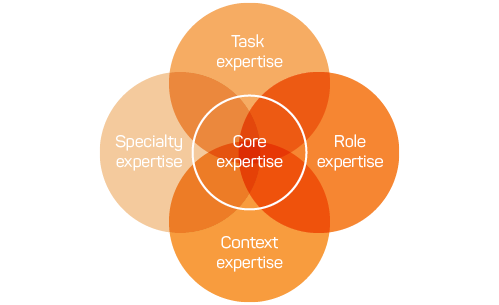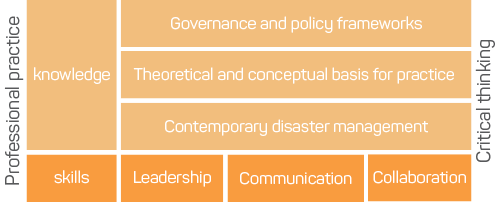Introduction
Over recent years there has been a strong public perception of the increased impact of disasters worldwide. This increase is compounded by the effects of climate change, population growth, the interconnectivity and complexity of modern societies, urbanisation and an increase in the proportion of vulnerable members of society.
There has thus been increased interest in enhancing the education and training of those charged with supporting, leading and managing communities. However, such programs need standardisation of curricula to ensure consistency and articulation between levels of training.
Tertiary education plays a key role in developing the capability of those tasked with leading efforts to improve emergency and disaster management. A curricula informed by industry needs and designed with a generic benchmark in mind is essential for effective tertiary education. Therefore, there is value in developing standards for emergency and disaster tertiary programs; standards that may facilitate international cooperation and exchange among emergency and disaster professionals and perhaps contribute to professionalisation.
The aim of this project was to develop a conceptual framework and standards for higher education programs in emergency and disaster management in Australia.
Methods of development
The Generic Emergency and Disaster Management Standards (GEDMS) for higher education was developed through a mixed qualitative research approach. The sources of information included:
- a comprehensive, international literature review to identify recommendations for course content
- a detailed analysis of current emergency and disaster-related university programs throughout Australia and New Zealand
- five focus groups of 34 interdisciplinary experts from government organisations
- two rounds of feedback involving those who participated in the focus groups
- broad-based consultation with industry representatives to test the validity, utility and appropriateness of the standards
- a one-day final seminar with industry representatives and relevant stakeholders.
This approach ensured that GEDMS was drawn from a comprehensive set of diverse data and reflected a sophisticated and holistic approach to the data analysis.
The context
The definition of ‘disaster’ is contested. The GEDMS do not focus on ‘business as usual’ but rather on those events that challenge communities and require special arrangements to be put in place. The standards focus on coping and adaptive capacities and building resilience. The GEDMS curricular goes beyond disaster response to encompass the strategies required to manage disasters and their effects throughout the continuum of the disaster cycle; the core concepts, principles and practices that, while complementing diverse expertise, also define the field.
The GEDMS should be read and applied within the following philosophical assumptions:
- disaster management is primarily local and community-based
- there is a wide diversity of roles and expertise involved in emergency and disaster management across individuals, organisations and communities
- there is a focus on the Australian tertiary education sector and the philosophies that underpin disaster management in Australia and the Australian Qualification Framework (AQF)
- there is a focus on core knowledge needed by the variety of participants in emergency and disaster management
- there is a comprehensive view that recognises the mitigation impact of strategies such as land-use planning, public health protections and building-construction standards
- there is a need for continual review and updating.
The GEDMS recognise that the scope of core competencies vary dependent on the role of the individual. All people should understand a small component of core knowledge while those accountable for leading policy development need an extensive understanding of the underpinning concepts, principles and practices.
The GEDMS also recognise that in addition to these core concepts there are task-specific, role-specific, context-specific and specialty-related knowledge and competencies required (Figure 1). These concepts can be described as:
- task-specific knowledge relates to the particular functions of various stakeholders
- role-specific knowledge relates to the roles and responsibilities of individuals and organisation
- context-specific knowledge= relates to particular physical and socio-cultural environments
- specialty knowledge is required for key elements of the emergency and disaster management continuum (e.g. particular expertise such as media and communication).
The GEDMS are not intended to address these later two domains as their diversity means that they cannot normally be provided by centralised (multidisciplinary) education, but rather by operational and specialised agencies or through specialised, disciplinary programs.

Figure 1: Relationship between core and specific expertise (knowledge and skills).
The Generic Emergency and Disaster Management Standards
The GEDMS have been organised around the required knowledge and skills needed to practice. The three main themes within the knowledge domain are governance and policy frameworks, theoretical and conceptual basis for practice and contemporary disaster management. The three themes that emerged within the skills domain were leadership, communication and collaboration. The two themes that emerged from the application domain were professional practice and critical thinking. These are represented in Figure 2.

Figure 2: Domains of the Generic Emergency and Disaster Management Standards.
Conclusion
The application of GEDMS to the development of university programs will vary according to the level of the program. All graduates would be expected to have a broad and coherent body of knowledge and be able to review critically, analyse, consolidate and synthesise knowledge, as well as identify and solve problems. However, the extent to which they do so and the complexity of the problems to which these core competencies are applied will vary.
The GEDMS project achieved extensive recognition regarding the value of the exercise. All parties involved recognised the need for a generic standard to inform the tertiary education of emergency and disaster managers. There remains a need for further consultation with the emergency and disaster management community to evaluate the GEDMS and to refine the main themes. The actual application of the GEDMS will inform future adjustments. Additionally, the implementation of these standards relies on a self-regulatory approach.
Further consideration should be given as to how the GEDMS inter-relate with vocational training programs. Any subsequent development of an integrated approach to training and education must facilitate an articulated education pathway for students.


